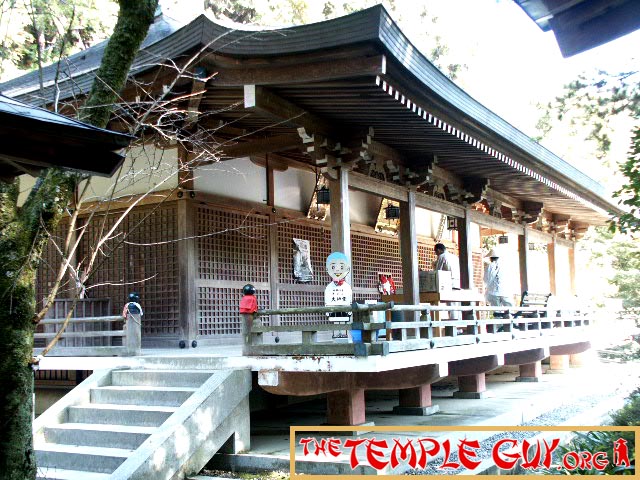Tuesday, October 30th, 2001
See here for the distances between temples
The Shikoku Pilgrimage
|
Preliminaries
Long day, short Logbook.
Although these two temples are accessible from Matsuyama, they are barely so. If I had it to do over again, I would probably arrange to stay at least one night at Number 44, allowing more time to see these two.
It's a long bus ride and a short (1 kilometer or so) walk out to Number 44; from there, Number 45 is only 11 K by vehicle, 9 K by trail. But the bus runs only three times a day between the two. I arrived at Number 45 at 2:19; the last bus of the day returned to the area of Number 44--and the connection for Matsuyama--at 2:59. And it's 800 meters up a hillside to reach the temple! I had to run back down. Originally I planned to walk the 9 K back to Number 44, but I realized that--starting at 3:00 or so--I would be benighted somewhere on a mountain trail. Not a good plan.
In a nutshell, I dashed through these two temples. They deserve better. The only pictures you'll see are on the Gallery pages. It's too bad; it's a beautiful area.
Temple #44: Daiho-ji (大宝寺)
|
This is a pretty little mountainside temple. At both temples today, one approaches the main gate from the side; there's just a little landing in front of the gate, so it's tough to get back far enough for a decent picture. For that reason, the Gallery shot of this gate is from behind. (I have front shots--in sections.)
The temple was founded by a Korean monk in the year 701. (Japanese Buddhism was actually instigated by gifts from the monarch of a Korean kingdom.)
Statler (and Ed) say the Daishi came through here and the area was so poor that there was just one lone woman living here. She begged him for company, so he caused a river to flow here. This created the possibility of growing crops, so people came, and a town grew up. That town is Kuma, named after the woman in question.
This story reminds me of a book given to me by Flora Cooper, one of my all-time favorite students. It's called The Man Who Planted Trees, and it's the beautiful story of a man who through years of planting one acorn at a time brought back a forest, which brought back the ability of the soil to hold water, which brought back agriculture and people to a blighted area.
After another bus ride I was at the base of the trail up to...
---GALLERY---
Temple #45: Iwaya-ji (岩屋寺)
|
This temple's location is truly spectacular. Note the stone in the background of this image of the temple's precincts. In the picture of the hondo in the Gallery, there's a ladder in the background. This leads up to a ledge, another ladder, etc., and finally an open-faced cave. On a nearby pinnacle, the Daishi is said to have done another of his "special" meditations.
Statler does a great job of describing this place. Here's a part of what he says:
"One cannot stand dwarfed before this towering natural altar without knowing that it has been a sacred place since man first found it. A god resides here. And holy men have come to sojourn with him."And holy women. Oddly, Statler fails to record the founding legend, given by the Bishop. A sennin--a woman sennin--named Hokke gave the site to the Daishi. This is the first time I've ever heard of a female sennin. Often translated "immortals," these are characters straight out of Chinese mythology. Through ascetic practices--perhaps related to the Taoist search for the elixir of life--these wandering recluses attained great power and longevity.
So both Number 44 and Number 45 owe their existence to both the Daishi and a woman. Given their proximity--as well as their isolation from the nearest other temples of the pilgrimage--I find this fascinating. Was there a community of women of power here?
---GALLERY---
Next Time
I deeply regret the speed with which I had to visit this place. Although my feet are glad I didn't walk the 10 kilometers or so between these temples, my eyes--and heart--wish that I had.
Next time, next time... I used to think that the stories I heard of people doing the pilgrim repeatedly (Don Weiss, who wrote Echoes of Incense, did it twice back-to-back; others have done it over 200 times) indicated some kind of... well... weirdness. Now I'm starting to understand. Sometimes I think I'd like to do it a little at a time, by car, dawdling here and there, sightseeing other things--castles, spas, public parks--along the way. Sometimes I think I'd like to do it all on foot, in one trip--this time without the computer and books, just one change of clothes, my beads and prayer book. Sometimes I think I'd like to do it alone; at others, with a Japanese companion along to translate, as Statler had; and at others, I imagine traveling with a lover, someone to reminisce with about the trip as we grow old.
But however I do it, if I do it, I'm definitely spending more time around these two temples.
| ← Previous Day | Back to Shikoku Pilgrimage Guide | Next Day → |
Posted October 15, 2019








No comments:
Post a Comment